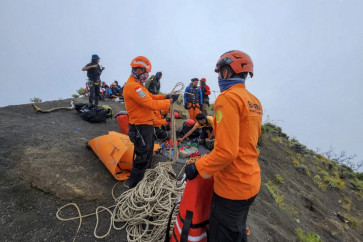Popular Reads
Top Results
Can't find what you're looking for?
View all search resultsPopular Reads
Top Results
Can't find what you're looking for?
View all search resultsNational park surveys Javan rhinoceroses
It seems no one is outside the reach of being surveyed, not even Javan rhinos
Change text size
Gift Premium Articles
to Anyone

It seems no one is outside the reach of being surveyed, not even Javan rhinos.
Ujung Kulon National Park (TNUK) has launched a joint team consisting of 80 officers from the TNUK, the Indonesian Rhino Foundation and the Bogor Agriculture Institute (IPB) to Ujung Kulon, which is located on the western tip of Java and is one of only two remaining natural habitats of the Javan rhinoceros.
TNUK head Agus Priambudi told journalists the team would start to counting the rhinos in the area by using capture, mark and release (CMR) methods, which is more accurate than the previously used Schenkel method.
“We estimate that there is a total of 50 to 60 Javan rhinos in the past 15 years,” said Agus.
The CMR method is conducted by placing camera traps in certain spots at the rhino’s habitat to capture images of the rhinos.
The sampling of images would be used to predict the actual number of the population.
“With the CMR method, we can directly see the animals through the video recordings and pictures, the age ratio and the sex of the rhinos,” he added.
Only five rhino species exist in the world today.
They are the black rhino, white rhino, Indian rhino, Sumatran rhino and the critically endangered Javan rhino.
The latter are found only in the TNUK and the Cat Tien national park in Vietnam.
Once the most widespread of the Asian rhinos, the species is today considered the rarest of the world’s large mammals.
During the last survey of the species, which was held in 2008, a team of researchers discovered the foot prints of four baby rhinos allegedly younger than one year.
Agus said the finding proved the rhinos are still procreating and regeneration is still possible.
“The team started its survey on Tuesday and it will run until Saturday,” he said.
He explained that the Schenkel method used between 1967 and 2008 are based on observing tracks of the rhinos’ foot prints.
Survey team officers would appraise the population and age classification of rhinos based on foot prints found on 15 permanent tracks within every 2 kilometers of the habitat area.
Agus said several studies have revealed the Schenkel method was inaccurate due to the high instance of human error, such as mistakes in measuring the foot prints and fatigue that occurred during the survey.
“Natural conditions may have also contributed to the baby rhinos’ foot prints that were found,” he said, referring to the fact that foot prints of the same individual could be printed differently due to external factors.









